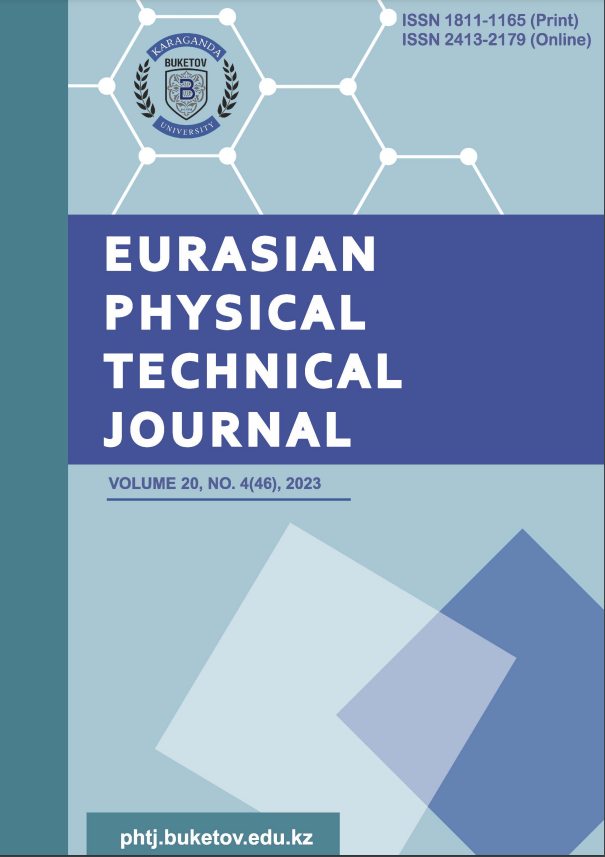QUANTUM-CHEMICAL STUDY OF THE STRUCTURE AND PROPERTIES OF MOLECULE OF THE LUPININE ALKALOID DERIVATIVE
DOI:
https://doi.org/10.31489/2023No4/33-38Keywords:
quantum-chemical calculations, quinolizine derivatives, conformational analysis, lupinin derivatives, X-ray diffraction analysisAbstract
The paper presents the results of a quantum-chemical study of the molecule 1-((4-(3-methoxyphenyl)-1H-1,2,3-triazol-1-yl) methyl) octahydro-1H-quinolizine. The geometrical characteristics of this molecule obtained from quantum-chemical calculations have been analysed and compared with experimental data of X-ray diffraction analysis. According to the results of the conformational analysis carried out by rotation along the labile bonds C11-N12 and C7-C11, the most favourable conformational states of the molecule have been established. It is shown that the localisation of the boundary molecular orbitals falls on the 1-ethyl-4-(4-methoxyphenyl)-1H-1,2,3-triazole substituent at the C11 atom, which suggests its participation in the subsequent modification reactions carried out to find new biologically active substances.
References
Sparatore A., Cagnotto A., Sparatore F. Quinolizidinyl derivatives of 2,3-dihydro-2-oxo-1H-benzimidazole-1-carboxylic acid and 1-homolupinanoyl benzimidazolones as ligands for 5-HT3 and 5-HT4 receptors. Farmaco,1999, Vol. 54, pp. 248–254. doi: 10.1016/s0014-827x (99)00025-7
Basilico N., Parapini S., Sparatore A., Romeo S., et al. In vivo and in vitro activities and ADME-tox profile of a quinolizidine-modified 4-aminoquinoline: A potent anti-P. falciparum and anti-P. vivax blood-stage antimalarial. Molecules, 2017, Vol. 22, pp. 2102. doi: 10.3390/molecules22122102
Rusconi C., Vaiana N., Casagrande M., Basilico N., Parapini S., Taramelli D., Romeo S., Sparatore A. Synthesis and comparison of antiplasmodial activity of (+), (-) and racemic 7-chloro-4-(N-lupinyl) aminoquinoline. Bioorg. Med. Chem., 2012, Vol. 20, pp. 5980–5985. doi:10.1016/j.bmc.2012.07.041
Vazzana I., Novelli F., Sparatore F., Sparatore A., Fadda G., Manca C. Quinolizidine derivatives with antitubercular activity. Farmaco, 1994, Vol. 49, pp. 105-110.
Basova N.E., Kormilitsyn B.N., Perchenok A., Rozengart E.V., Saakov V.S., Suvorov A.A. Reversible lupininin inhibitors of cholinesterases of mammalian blood and of optical ganglia of individuals of the commander squid Berryteuthis magister from different zones of species areal. Zh. Evol. Biokhim.Fiziol., 2012, Vol. 48, pp. 213–218.
Rozengart E.V. Bisalkaloid derivatives of dicarboxylic acids on the basis of lupinine, anabasine, and cytisine as reversible cholinesterase inhibitors. Dokl. Biochem-Biophys., 2003, Vol. 388, pp. 39–42. doi: 10.1023/a:1022560630021.
Tasso B., Catto M., Nicolotti O., Novelli F., Tonelli M., Giangreco I., Pisani L., Sparatore A., Boido V., Carotti A., Sparatore F. Quinolizidinyl derivatives of bi- and tricyclic systems as potent inhibitors of acetyl- and butyrylcholinesterase with potential in Alzheimer’s disease. Eur. J. Med. Chem., 2011, Vol. 46, pp. 2170–2184. doi: 10.1016/j.ejmech.2011.02.071
Tonelli M., Catto M., Tasso B., Novelli F., Canu C., Iusco G., Pisani L.,De Stradis A., Denora N., Sparatore A., Boido V., Carotti A., Sparatore F. Multitarget Therapeutic Leads for Alzheimer’s Disease: Quinolizidinyl Derivatives of Bi- and Tricyclic Systems as Dual Inhibitors of Cholinesterases and β-Amyloid (Aβ) Aggregation. ChemMedChem., 2015, Vol. 10, pp. 1040–1053. doi: 10.1002/cmdc.201500104
Nurmaganbetov Zh.S., Fazylov S.D., Turdybekov K.M., Nurkenov, et al. Synthesis and structure of 4-substituted (1S,9aR)-1-[(1,2,3-triazol-1-yl) methyl] octahydro1H-quinolysines of lupinine. Bulletin of the University of Karaganda – Chemistry, 2022, Vol.106(2), pp. 12–22. doi:10.31489/2022Ch2/2-22-5
CrysAlisPro. Yarnton, Oxford shire, England: Agilent Technologies Ltd., 2014, 60 p.
Sheldrick G.M. A short history of SHELX. Acta Crystallogr A. 2008, Vol. 64(Pt 1), pp.112-122. doi:10.1107/S0108767307043930.
Stewart J.J.P. Optimization of parameters for semiempirical methods V: Modification of NDDO approximations and application to 70 elements. J. Mol. Modeling, 2007, Vol. 13, pp. 1173–1213. doi: 10.1007/s00894-007-0233-4
Frisch M.J., et. al. Gaussian 09, Revision D.01, Gaussian, Inc., Wallingford CT, 2009. https://gaussian.com/g09citation/
Koziol A.E., Gdaniec M., Kosturkiewicz Z. Structure of (-) – lupinine. Acta Crystallogr, 1980, Vol. 36, pp. 980-981. doi: 10.1107/S0567740880005080
Allen F.H., Kennard O., Watson D.G., Brammer L., Guy Orpen A., Taylor R. Tables of bond lengths determined by X-ray and neutron diffraction. J. Chem. Soc. Perkin Trans., 1987, Vol. 2, Issue 12, pp. 1–19.
Koziol A.E., Kosturkiewicz Z., Podkowinska H. Structure of the alkaloid lupinine. Actacrystallogr, 1978, Vol.34, pp. 3491-3494.
Duax W.L., Norton D.A. Atlas of Steroid Structure, New-York, 1975, 18 p.
Shiryayev A.K. Kvantovaya khimiya. Samara: Samara State Technical University, 2020, 134 p. [in Russian]
Kovalskyi Y., Kostiv I., Marshalok O., Vytrykush N. Quantum-chemical research of mechanism of the reaction dehydration of 2,3-dimethylbutan-2,3-diol and it’s hexahydrate. Eastern-European Journal of Enterprise Technologies, 2013, Vol. 6/6, (66), pp.11-15. doi:10.15587/1729-4061.2013.18864
Kopbalina K.B., Mazhenov N.A., Bimbetova G.M. Quantum-chemical calculations of the structure and electron transitions of multimolecular films. Eurasian Physical Technical Journal, 2019, Vol.16, No.1(31), pp.62-68. doi:10.31489/2019No1/62-68
Tsyshevskiy R.V. Kvantovo-khimicheskiye raschety mekhanizmov khimicheskikh reaktsiy: teaching manual. Kazan, Kazan National Research Technological University, 2012, 88 p. [in Russian]













